#transposed modes
Explore tagged Tumblr posts
Text
OH MY GOD I JUST SAW THE NEW PATCH NOTES level 35 umbral soul?? i am whooping and cheering and throwing my hat up in the air this was so fucking needed...
#the nemesis speaks#swift plays ff14#like before the mp changes it wasn't an issue bc umbral ice had passive mp regen BUT they took that out now#so that you need to cast an ice spell to get your mp back#which you... can't do out of combat#(which is a better system tbc the old mp regen method made you awkwardly wait in ice mode sometimes and drop dps)#but whereas before when you could just transpose to ice at the end of combat and let your mp come back#post 7.0 that was no longer a thing and you just. couldn't get mp back very quickly#but umbral soul is an out of combat ability with mp regen! and now you can use it at low levels! WHOO!
1 note
·
View note
Note
hey ct :) the other day i posted some medieval music theory diagrams and i was really struck by how similar some of them look to kabbalistic diagrams, which made me wonder about the intersection of musicology and cosmology/philosophy/occultism (?) in general, particularly in the middle ages. obviously this is an extremely broad topic, sorry. i just feel like from a modern standpoint it's easy to forget how essential the study of music theory was to the medieval education system and how intertwined it was with arithemtic and geometry. so i'm just curious, are there any medieval thinkers/traditions that come to your mind that took abstract structures proposed by music theory and sort of went ontologically wild with them, i.e. mapped them onto the structure of reality/the universe itself?



Utriusque Cosmi, Maioris scilicet et Minoris, 1617 (Robert Fludd)
Practica musice, 1496 (showing Apollo, the Muses, the planetary spheres and musical modes)
Phonurgia Nova (New Science of Sound Production), 1673 (This text itself isn't occult, but Kircher himself fits the bill) (Athanasius Kircher)
Kinda! Allusions to the universe as fundamentally musical in nature go back to Pythagoras. It meshes well for antique and medieval doctrines of amity and antipathy, which transposes neatly onto harmony and disharmony. It was often compared to the orbits of the planets, each orbiting at a set distance from the earth in accordance with some greater universal harmony. As far as I'm aware, that wasn't an uncommon way to think of the world.
Music theory is one of those things that gets transposed onto basically everything. If a religion goes on for long enough, you can basically assume that someone will develop some interesting spiritualized music theory. Its not something I've ever delved into personally, largely because I find music theory confusing.
As for Kabbalistic literature specifically, the story goes that Issac Luria was inspired by watching the sun filter through a complex fountain in Safed. I've always associated post-lurianic diagrams with flowing water. But if I recall correctly, Hebrew letters were also regularly used for musical notation, so music-as-mysticism is only a stones throw away. I would be shocked if writing on the subject doesn't exist.
Personally, music-as-mysticism is something I generally associate with Sufism. I know Inayat Khan was popular in part because of both his musical talents, and his doctrine that incorporated musical concepts. But he was pretty modern!
198 notes
·
View notes
Text
i like doing the free syndicated version of the nyt crossword that the seattle times runs (no account no ads etc) because once every 3–4 months it will have an inexplicable fuckup where some of the clues are listed by the wrong number and you can only figure this out by being extremely confident about an answer and then realising on cross that it can't actually go there and then you have to hunt around the puzzle for where else in the fill you can fit RICEARONI and try to figure out the pattern of what clues got transposed where it's like playing on rube goldberg mode
62 notes
·
View notes
Text
integrating real space and digital space in gelboys

one of my favorite things about gelboys is how it harnesses contemporary social media as a kind of semiotics—how meaning is coded and transmitted—that is rooted in the way young people socialize and perform rituals of courtship in both real space and digital space. for instance, how certain actions can signal interest or affection (making a shared playlist, adding someone to close friends), or keep a person at distance (leaving them on read, blocking obviously). or how moments and actions are simultaneously mutable (deleting a line message, changing a username) and preservable (taking a screenshot, saving a tiktok).
at the same time, gelboys excels at establishing vivid and specific physical locations to anchor the humanity of the characters and storylines. school, siam square, the nail shop, bedrooms, every detail even down to specific charging outlets. in real space, the camera can do its work through blocking, framing, lighting, movement, and the acting itself; this has been the focus of my cinematography posts.
but what makes this show so special to me—and, I think, a lot of others—is the way boss kuno and his team were able to transpose and integrate the semiotics of that digital world into the physical setting and action of the show through innovative visual storytelling. (the sound design was also tremendous, but that's harder to break down without the aid of video lol.)

finding meaning beyond the screen
while the digital world offers these teenagers new modes of expression and interpretation, it is also very much a limited, often self-edited form of communication. first of all, a phone screen is only so big, and many video platforms encourage portrait view, so the narrow physical frame of the device itself can necessarily only show a subjective truth. in that way, the screen acts as a depository where the characters can store their fantasies of who they want to be and how they want the world to perceive them—fourmod playing around with chian's picture to mimic a kiss, bua filming take after take of a dance challenge. and it makes them performers of their own lives and voyeur-observers to each other's.
the show cleverly delineates that exact tension between text (i.e. the content being uploaded to social media) and context (everything that gets cut off in the wider view, or happens before or after the clip) in scenes like this:


the crop overlay visually separates the imagined digital space from real space, so there's an additional layer of symbolism to be found in the context. chian and bua dancing together conveys one meaning for the viewers on tiktok and a separate meaning for fourmod, who is in the frame in real space but not digital space. here he is both the observer (the one filming) and an object affected by the act of observation (the emotional distance he feels as the scene progresses, which is emphasized by his positioning). the way gelboys builds and conveys these layers of meaning by visually integrating digital space into real space is such a treat.
sites of action in digital space
even if digital space is a non-physical entity, that doesn't mean it can't serve as a site of action, and gelboys deliberately stages crucial moments within that virtual realm: chian switching between bua and fourmod on his close friends list, baabin's confession and deleted messages, the zoom summit, to name a few. in fact, thinking back on the scenes that elicited some of the strongest visceral reactions across fandom, quite a few of them stemmed from actions that took place on social media rather than real space. here's a little thought exercise:



is the action shot of fourmod panic-scraping his nails off more or less violent than watching him delete his shared playlist with baabin or create and post an AI video of faifa? (actually wow I might come back to fourmod re: this topic later lmao help) arguably, the audience recognizes the semiotics of those actions—deprioritizing baabin's friendship once he has chian's attention, intentionally doing something to make faifa hate him, not to mention the deepfake part of it—so even though all we're looking at in the exact moment of action is a mouse hovering over the "post" button or an app UI, we still feel as strong of an emotional impact as if fourmod had done something equally appalling in real space.
digital ephemera and memory
people tend to think of social media as a primarily transient mode of communication, and although much of it can be (ignore the data sitting in a physical server somewhere), gelboys shows its characters preserving—and erasing—a great deal of digital ephemera as a mode of memory.
three of the four gelboys are constantly creating collections of messages, photos, etc. (beyond what they post on their accounts) that serve as digital scrapbooks where their truest feelings are kept, and they do it in ways that reflect their individual characterizations. baabin takes screencaps of his conversations with fourmod and hides them away in a folder on his phone, while chian squirrels away his affection for fourmod on a secret account; in this, too, they are two sides to a coin. bua, meanwhile, stores his memories in the form of tiktok drafts—a sort of digital limbo. in his charging gel episode, his phone is running out of storage, an apt metaphor for needing to let go of his friendship with chian. baabin gives him the option of transferring them over instead, but it's unclear whether bua actually ends up doing that. in either case, the collection of ephemera is no longer in his possession.

(fourmod is not really shown doing this—he tends to do the opposite, and is 1000% gonna get his own post about it)
so it's momentous when baabin deletes his entire fourmod folder, when chian airdrops fourmod his old photos and posts his apology as an IG highlight despite knowing he's blocked. like bua, baabin clears out his storage, removing the record of what he once felt for fourmod. and chian is no longer trying to keep his feelings to himself, but rather choosing to show fourmod his collected memories directly; he wants fourmod to remember as well. social media allows us to pick and choose which memories to keep and which to let go, and the emotional changes for three of the four gelboys can be easily tracked by these acts of preserving and discarding digital ephemera.
in gelboys, the importance placed on both real space and digital space, and the visual language used to merge the two, invites the audience to parse the story on multiple levels, but the reward for investing that energy is monumental. it feels like every time I think I've exhausted my thoughts on one topic, a few more pop up. anyway, thanks as always if you read all of this!

#gelboys#gelboys the series#gelboys cinematography#this show has me skimming barthes on a friday night#it's terminal i'm afraid#yes i was a film major
55 notes
·
View notes
Text

Pastoral with a Bagpipe Player
Artist: François Boucher (French, 1703 - 1770)
Date: 1749
Medium: Oil on canvas
Collection: The Wallace Collection, London
Description
With its pendant, P482, the painting represents some Boucher’s most ambitious works in the pastoral mode. Boucher continued the pastoral, utopian mode of Watteau's Fêtes galantes, anchoring them more clearly in an idealised, Italian setting. By exchanging Watteau's contemporary Parisians with idealised shepherds and shepherdesses, Boucher further removed the scenes from a recognizable contemporary reality, transposing them into an entirely imaginary world. While Watteau produced cabinet-sized pictures, Boucher often employed the pastoral for large-scale room decorations, as is the case here.
The two pictures originally belonged to the Daniel-Charles Trudaine, who worked as governor of the Auvergne, before being put in charge of roads and bridges in France, a capacity in which he was responsible for extending and modernising the network considerably. From 1745 he instigated and supervised the production of a new street atlas of France. Trudaine hung the two paintings in the grand salon on the ground floor of his country house at Montigny–Lencoup near Fontainebleau.
The scene was inspired by the theatrical characters of the immensely popular pantomimes of Boucher's friend, Charles-Simon Favart. At the Opéra Comique, where Boucher was both set designer and a keen member of the audience, Favart’s musical dramas combined the Arcadian idealism and aristocratic sensibilities of pastoral poetry with the rustic, sentimental characters of popular theatre. The painting depicts the cousins Lisette and Babette with the little shepherd who wins his sweetheart’s affection and a crown of flowers by serenading her on the bagpipes.
#painting#pastoral scene#oil on canvas#fine art#theatrical characters#landscape#pastoral poetry#popular theatre#women#man#bagpipe#animals#distant city#cloudy horizon#costume#theatre characters#trees#foliage#french culture#francois boucher#french painter#french art#oil painting#the wallace collection#artwork#european art#18th century painting
25 notes
·
View notes
Text
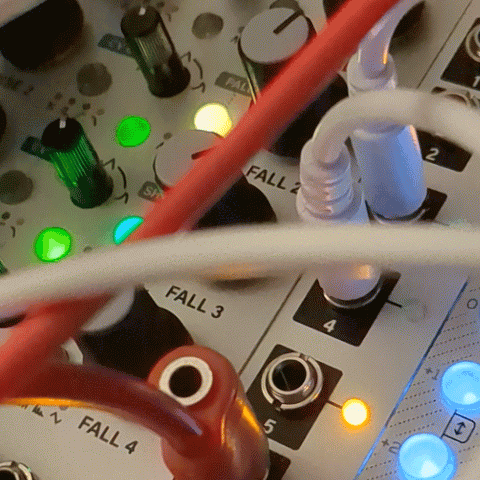
Complex sounds, complex processing.
I think this is going to be it, or at least close to it: a case where I can make a more full range of sounds. I think I'll need to swap Pachinko out for Sinc Bucina and Pam's, but otherwise, it's a great case to explore some of these deep modules - there's a lot of underutilized digital potential in my racks.
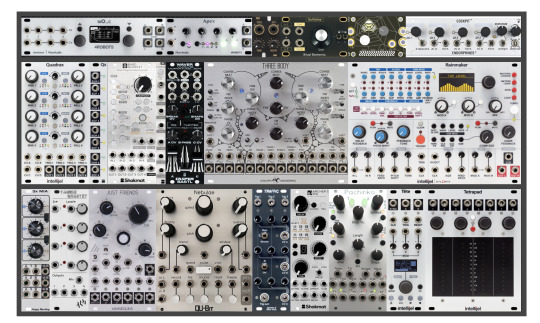
There are two main voices here, both driven by Marbles - one FM voice from Three Body through Waver, Rainmaker, then Bib; the other Just Friends through Nebulae. Rainmaker is running my own preset which started off as something to "make a beat" out of an incoming texture, but really just adds some churning rhythm. I turn a handful of taps on and off throughout to change it up, and Marbles fluctuates a bit, but otherwise this portion is fairly static. Just friends is in Floom mode (if I remember correctly - the LPG simulation) with 3xMIA mixing an offset with S&H from Noise Tools (in the case instead of Apex, but this will change) to adjust the length - in the future, I think I'd like this adding some dynamics to volume, too, since it feels a little motionless throughout despite parts changing.
While there's less sequential variation though, the real interest in this part (and dare I say, the whole recording) is in live playing of Nebulae's buffer, creating all sorts of pleasing loops and textures. I'm just scratching the surface, but this jam was the first time I've felt I was "playing" the module with some intention rather than just turning knobs and trying to figure out what was happening. Turns out, less is more with this one.
Some other interesting mechanics: I'm using Tetrapad in keyboard mode as a sort of master transpose for the patch, with pressure out letting a sine from Osc 3 into Rainmaker for more tones (I play this near the end) and there's also a simple hat pattern from Archer's Rig (new!) clocked by a bouncing ball from Quadrax.
As this case is all together, and I really want to learn, hope to have more out in this vein soon!
#eurorack#modular synth#gif#flashing gif#technology#cybercore#tech aesthetic#aesthetic#cyber aesthetic#industrial music#artists on tumblr#my art#my music#ambient music#technomusic#electonic#electronic music
25 notes
·
View notes
Text
i am once again thinking about the old-qud new-qud dialectic metalayercake reading and: (ENDING SPOILERS)
it's very interesting to me that the two ending quests of qud, in order, are "go around and pulverize these guys wolfenstein style with your big roguelike numbers", and then a sequence that could be transposed into a twine game without much loss, and then epilogued by a complex generative historysystem that warps things even going down to the faction system to tell its story. that's like qud's three modes of narrativemaking right up against each other in a little planned sequence. thesis (old qud traditional gamma world roguelike), antithesis (a capital-A Adventure Game, hindrens guide to qud style, New Qud), synthesis (village generation system that pools on the player's mechanical journey and transforms it into a little new world, new-new qud? dwarf fortress-qud synthesis thought? kitfox? still drawing the lines here)
under this framework i still consider reclamation the weakest part of the game's ending, but it makes a bit more sense. it's brutal and simple in its representation of its respective narrative mode, but maybe some sort of golgotha-like dungeon where the tile-world and terrain could shine a bit more would've made it stick out more? golgotha to me feels like maybe the stickout prime example of this sort of play, if only because of my fond memories of experiencing the sort of genuine tension and fear that comes from a permadeath roguelike within it
12 notes
·
View notes
Text
Word changes...
All of the following is IMO, so YMMV. :->
*****
Anyone noticed how "weaponry" is used nowadays in places where "weapons" would work just fine (and is often more correct)?
Yes, they ARE interchangeable, sort-of, but it's clunky and sounds to me either slightly journo-pompous or like a failure to remember the right word so plugging the most similar one into its place.
ETA: I checked one of my dictionaries, and while "weapons" is more modern, "weaponry" is an obsolete word which has come back into favour. I wonder why...?
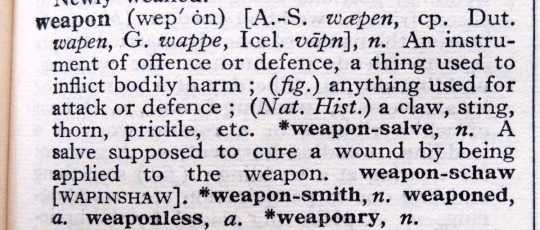

*****
"Decimate" turns up all the time, usually when the correct word is "devastate".
Merriam-Webster says: "It's totally fine to use 'decimate' as a synonym for 'devastate'. This is why."
Beg to differ.
As the M-W article points out, "decimate" originally meant a Roman military punishment applied to one man in ten of a guilty unit. (Initially execution, but this had a rotten effect on unit morale, so it was reduced in severity to fatigues, extra drill or restricted rations.)
That's now considered a far too specific meaning and only linguistic pedants dig their heels in. Quite right too, and I speak here as a (bit of a) linguistic pedant...
However, it remains a useful word for more generalised incomplete destruction of living things - saying a regiment, flock, herd or population was "decimated" implies there are some survivors without quibbling over how many tenths. If totally wiped out, however, that's when words like "destroyed" or "obliterated" are more appropriate.
On the other hand something inanimate like a factory, city or region would be "devastated" - and in addition, saying someone is emotionally devastated is understandable, but saying they're emotionally decimated is peculiar.
Two words, several meanings.
It's like cutlery: a spork can replace knife, fork and spoon, but individual utensils give a lot more precision and variation of use.
*****
There are also a couple of real howlers, not just transposed words but actual errors.
One I've heard several times is using "siege" (a noun, or thing) instead of "besiege" (a verb, or action).
For reference, there's a term called noun-verbing, and the practice is quite old: "table the motion / pencil you in / butter him up / he tasks me", but all are either when there isn't already a verb-form of the word, or as a more picturesque way of saying something.
(Interesting side-note about "table the motion": in US English, it means "to postpone discussion" while in UK, CA and I think AU English, it means the complete opposite, "to begin discussion". Why there's this difference, I have no idea, but it's worth remembering as a Brit-fix when writing, also in a real-life business context.)
There IS an existing verb for the action of surrounding a castle and cutting it off from outside help, and that verb isn't "sieged". It's "besieged" or "under siege". Anywhere using "sieged" as a verb is wrong. The Firefox spellchecker in Tumblr Edit Mode is telling me it's wrong right now.

Merriam-Webster, I'm looking at you again.
*****
There's also "coronate" used as a verb. "The King was coronated at Westminster Abbey". Nope. He was CROWNED.
Coronate is an adjective (meaning crown-shaped) and was coined in in the 1600s by a botanist, as a word to describe the shape of certain plants.
The current Royal-associated usage seems to be a bastard back-formation from "coronation", because the act of putting on a crown is the verb "to crown".
This is almost identical in German, French, Italian and Spanish, with noun and verb the same. The only difference is that their verbs have, what a surprise, verb-endings (-en, -er, -re and -ar) on the noun while English does not.
Because English doesn't like to make things that easy...
"Coronated" might be people trying to sound archaic, or those who've bought into the dopey "said-is-dead" school, who perform any linguistic contortion to avoid common words, and who've been taught that repetition in a sentence - "crowned with a crown" - is BAD.
Is "coronated at a coronation" in some way better?
Guess what's got uncritical examples...
If that's M-W scholarship, I'll stick to the OED and my old but utterly reliable New Elizabethan Dictionary, thanks very much.
*****
Language is funny: sometimes funny ha-ha, sometimes funny annoying, but often just funny peculiar, because English etc. etc...
79 notes
·
View notes
Text
omg realizing i have so much shame abt music school and my difficulty with music theory (the math of it all) that my gf thought I didn't know what C WAS ON THE PIANO. i'm mad slow at theory so i don't talk to other musicians bout it bc no i won't be able to play or write a suspended 7th on the fly but i had to transpose for my entire jazz band (as a vocalist), was in choir for several years, have over 15 years of vocal training, AND have a good chunk of piano lessons
i can't even blame her bc of how little i talk abt knowing anything about this specific part of school but they didn't know that i flunked my theory course because of 18TH CENTURY COUNTERPOINT and actually did passing decent on my modes, solfege, and piano
#i gotta start giving myself more credit#like i literally am a musician#vocalists are musicians i gotta stop downplaying myself#life and times
3 notes
·
View notes
Text
Capturing the ambience of Pikmin (2001)
Disclaimer: I only explored the Gamecube v1.0.1 release. The Wii and Switch ports may require different tooling.
Extracting audio sequences
We'll be using piki-tools for its dedicated Pikmin 1 support. It offers a BARC tool for extracting pikiseq.arc - but first, we'll need a HED file to pair with it. Download one or extract it yourself from the sys/main.dol file. It starts with "BARC----" and ends shortly after "result.jam".

Contrary to the README we won't install piki-tools executables through pip - instead, we'll just run them from source. First, move the executables (e.g piki_barc) to the repo root (i.e. from piki-root/piki-root -> piki-root). Now, place your HED and ARC pair in the same directory and run:
"C:\Program Files\Python\Python313\python.exe" piki_barc.py EXTRACT "F:\Pikmin GC dump\files\dataDir\SndData\Seqs\pikiseq.hed"
This gives us a collection of JAM files, also known as BMS files.
Playing audio sequences
We'll use the unreleased JaiSeqX for its Pikmin 1 support.

Before running JaiSeqX.exe, copy Pikmin's Banks folder from SndData to the same directory as JAISeqX.exe, and run something like:
jaiseqx.exe "A:\Pikmin 1\GC sources\SndData\Banks\pikibank.bx" visu "A:\Pikmin 1\GC sources\extracted pikiseq.arc\d_end2.jam" 0 -libjaudio.force_init_version bx -jdsp.forcemap_ibnk_bx 13 -transpose 12
Extracting audio samples
Use XAYRGA's toolkit for Pikmin 1. Extract the archive into Pikmin's "SndData" and run _jamt_initialize.bat. The AW soundbanks will be unpacked into the Audio_Modding\SoundEffects\wav folder.
Appendix 0: Capturing footage
This should be possible using Dolphin's free look mode, with either the GC or Wii versions, albeit with some drawbacks on screen-space effects. There is also Heebo's free camera hack for the Switch version running on emulator. For a weirder solution we can run Pikmin 1^2 and PikHacker's freecam Gecko code. To skip levels on the Wii release, we can re-enable debug mode using a patch.
Appendix 1: Other extraction tools
BrawlCrate can supposedly explore ARC and BARC but I couldn't get it working for Pikmin 1. I had no luck with LunaBoy's RARC tool, either.
Appendix 2: STX files
These are AFCs and can be played with vgmstream.
Appendix 3: H4M files
You can extract these with h4m_audio_decode.
3 notes
·
View notes
Text
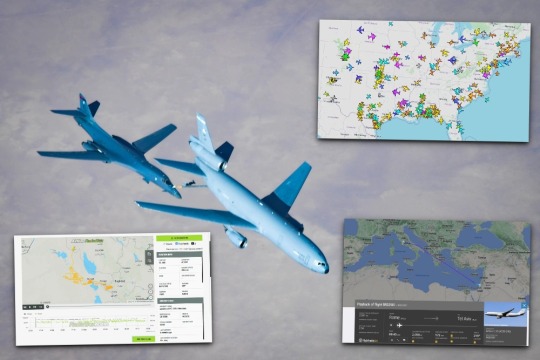
How to identify and track military aircraft in online applications
It is surprisingly easy to track what is flying above you, but there are limits - you will still see only what the military wants you to see.
Fernando Valduga By Fernando Valduga 12/24/2023 - 14:40 in Military
The system, known as ADS-B, allows you to quickly search for what is flying in your vicinity, or even on the other side of the world.
In the past, before the 2000s, people looked at the sky and saw the trail of condensation created by commercial and military jets at high altitudes and wondered what would be the aircraft that passed over our heads, where it was going, where it came from. Today, thanks to a worldwide transponder system, you can track even U.S. military aircraft.
About a decade later, it was already possible to follow commercial aircraft, knowing which airline, flight level, speed and route taken by the flights, being able to accurately follow the arrival of a plane at the airport.
Currently, equipped with a smartphone and with a particular app or website, we can find all this and much more.

Civil aviation authorities around the world began to implement Automatic Transmission of Dependent Surveillance (ADS-B) in the early years. The ADS-B is an aircraft-mounted transponder system that transmits a variety of information in real time, including the location, speed, direction of the aircraft and a unique transponder code for each aircraft. This information, plotted on a map, gives pilots and ground controllers the ability to quickly get a sense of the local airspace (or the airspace of most places on Earth).
Transponder signals can also be captured by cheap terrestrial receivers that amateurs, aviation enthusiasts and others can build for less than $100 using widely available hardware and software, some of which can be obtained on flight tracking sites.
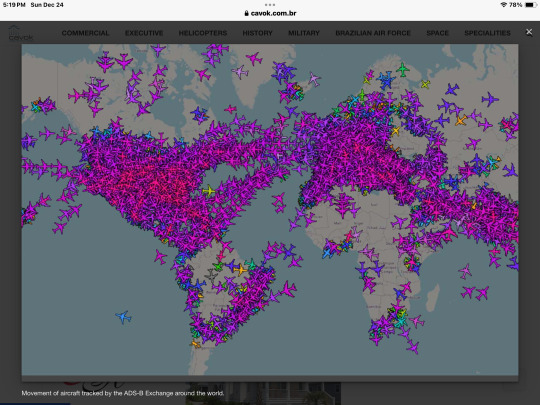
Movement of aircraft tracked by the ADS-B Exchange around the world.
As of 2021, ADS-B transponders are mandatory in the USA, Europe, Australia, Colombia, India, Indonesia, Malaysia, New Zealand, Papua New Guinea, South Africa, Taiwan and Vietnam, and the system is being implemented in China, Canada and Saudi Arabia.
In the United States, almost every type of aircraft - from commercial aircraft and small private aircraft to military fighters, helicopters, bombers, tankers, information-collection aircraft, transport, special operations aircraft, drones and even VIP aircraft carrying the president and members of Congress - are required to transpose into controlled airspace.
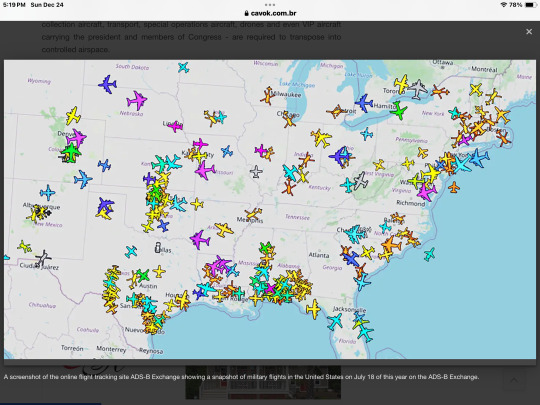
A screenshot of the online flight tracking site ADS-B Exchange showing a snapshot of military flights in the United States on July 18 of this year on the ADS-B Exchange.
The information is not only available to the aviation community. The ADS-B Exchange website gathers aircraft tracking data and makes it available in real time, allowing anyone to track air traffic anywhere the system is working.
Unlike FlightRadar24.com or FlightAware.com - which rely on flight tracking data streams provided by the FAA and other international aviation authorities or obtained from Aireon's global ADS-B air traffic surveillance and tracking network, as well as ground-based ADS-B receivers - ADSBExchange.com relies on thousands of independently owned ground-based ADS-B receivers and multilayer devices, or MLAT.
youtube
MLAT receivers in groups of three or four in a small geographical area use triangulation to track aircraft. In other words, if an aircraft is not using ADS-B for transponder as military aircraft sometimes do, MLAT receivers can still capture their S-Mode transponder signals and establish a position and tracking for an aircraft, as well as altitude and speed data.
The network of receivers of the ADSBExchange.com website includes 10,000 MLAT devices worldwide. As it does not collect flight tracking data from government or commercial sources, it may offer "unfiltered" flight tracking.
ADS-B Exchange merges ADS-B data with other publicly known data on military and civilian aircraft around the world. Individual aircraft are plotted on OpenStreetMap - a free geographical database of the world - represented by color-coded icons according to altitude. The icons range from individual autostos and Cessna 182 to four-engine Boeing 747 and Airbus A380 civil aircraft. Military icons include U-2, KC-135 Stratotankers, C-17 Globemaster III, C-5M Super Galaxy, V-22 Ospreys and so on, although fighters are often represented by a more generic icon model of swept wing and stuffy nose.
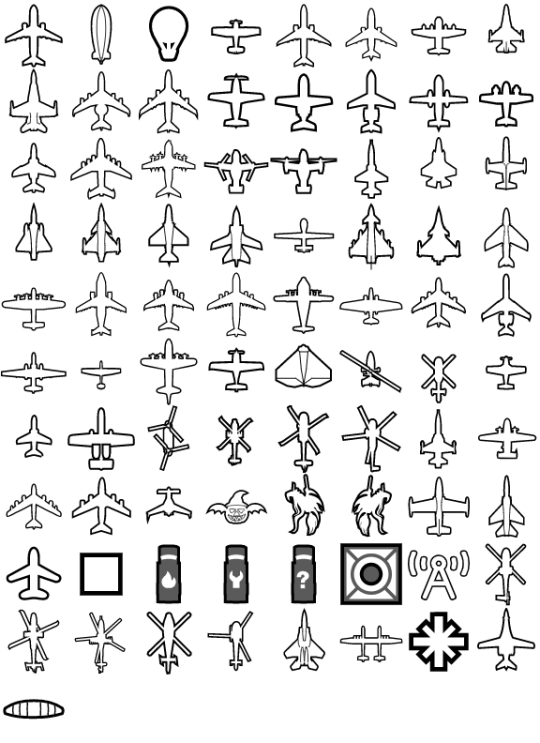
A click on the icon includes spatial information, including ground speed, altitude and location, ADS-B signal strength and other data. It also includes the registration of the aircraft, the country of registration and adds a photograph or thumbnail of the aircraft when possible.
All this means that, with the click of a button, you can instantly find out what is flying near you.
Although aircraft tracking has long been a niche hobby among aviation enthusiasts who like to catalog the comings and goings of aircraft, the public availability of transponder data in mid-air also offers journalists, researchers and other observers an effective means of tracking the movements and activities of the planes of the richest and most powerful in the world. The aggregation and analysis of public flight data shed light on the CIA's torture flights, the movements of the Russian oligarchs, and Google's friendly relationship with NASA.
Flights from ISR platforms tracked in the Ukraine region for a period of one month, at the end of last year.
More recently, these tracking techniques have gained international attention after attracting the wrath of Elon Musk, the richest man in the world. After buying social media giant Twitter, Musk banned an account that shared the movements of his private jet.
Despite repeated promises to protect freedom of expression - and a specific promise not to ban the @ElonJet account - on the platform, Musk censored anyone who shared the whereabouts of his plane, claiming that the data obtained entirely legally and totally public was equivalent to "murder coordinates".
A Global Hawk flown remotely with the indicater FORTE12 was the last aircraft tracked over Ukraine before the invasion of Russian forces and the closure of the country's airspace to civilian air traffic, according to the global flight tracking service Flightradar24.
Soon after the Russian invasion of Ukraine, a US Global Hawk, with the indication FORTE12, was followed almost daily by thousands of people on the Flighradar24 platform.
Publicly available flight tracking data is a growing problem for the U.S. military, a senior Pentagon official said recently.
Sites such as ADSBExchange.com, FlightRadar24.com and FlightAware.com aggregate flight data in the United States and abroad using a combination of commercial and citizen-owned sensors that capture the movements of commercial, civil and military aircraft in real time, 24 hours a day.
"The Department of Defense considers open source flight tracking and data aggregation on our aircraft a direct threat to our ability to conduct military air operations around the world," the U.S. Air Force said.

An F-35 fighter was tracked in the Flightradar 24 app earlier this year, during a flight near Phoenix, Arizona.
Aggregated by websites and retransmitted on social media accounts, the data can be a free source of intelligence for nation-states, terrorist groups or individuals, revealing everything from operational movements of aircraft, aviation units and troops to training standards, development test flights and the movements of government officials, experts said.
This image shows a Beechcraft King Air configured for intelligence, surveillance and reconnaissance missions in the military aviation field of Baledogle, Somalia, in 2021. The U.S. civil registration code on the side was not assigned to any specific aircraft at the time and its exact operator remains unknown. However, this is very much in line with the types of aircraft that JSOC allegedly operates clandestinely and that would be interested in hiding the activities through the proposed aircraft flight profile management database tool.
Therefore, military aircraft routinely transmit their ADS-B data, but have the option to turn it off when necessary. The Pentagon is well aware that aviation enthusiasts - and potential opponents - monitor ADS-B data and that aircraft turn off transponders when they do not want anyone to observe them. Often when following the aircraft they simply disappear abruptly from the map.
The U.S. military is also known to use fake hexadecimal codes, which identify a transponder as belonging to a specific aircraft, to help mask certain sensitive flights. For example, the U.S. Air Force VC-25A Air Force One jet that transported President Donald Trump to Afghanistan in 2019 electronically disguised itself for a time as a KC-10 Extender tanker in this way.
As a particularly notable and relevant example of tracking high-profile U.S. military flights, the U.S. Air Force C-40 Clipper aircraft that transported Nancy Pelosi, then a representative of the Democratic Party in California and mayor, to Taiwan last year was visible online, despite concerns that the Chinese military might try to forcibly prevent the flight from reaching the island or harassing it otherwise.
This flight, which used the SPAR19 indicative, was one of the most tracked of all time in terms of total simultaneous users monitoring it on the popular website FlightRadar24, and ended up taking down the app for a period of time.
The Ghostrider trail on the night between November 20 and 21, 2023, on Radarbox.com.
In mid-November, something new happened: a U.S. aircraft involved in combat apparently left its ADS-B on, and did so intentionally. An AC-130J Ghostrider attack aircraft carried out an airstrike against a target that had launched a missile attack against U.S. forces at Al Assad Air Base in Iraq. The AC-130 gunship has a variety of weapons, including 30mm and 105mm cannons, and precisely guided bombs and missiles, and usually flies in lazy circles above its target, pouring firepower on the targets below. In Al Assad's retaliatory air attack, according to The Aviationist website, the Ghostrider involved apparently kept his transponder on all the time, drawing large circles on the ADS-B map and it was possible to be seen on the Radar Box website.
In Brazil, it is possible to track several military aircraft in aircraft tracking applications, including the most widespread Flightradar24. Next, you can see the KC-390, C-130 Hercules transport aircraft or T-27 Tucano coaches in flight near the Air Force Academy. The FAB has hidden data from the presidential aircraft A319 (VC-1) and E190 (VC-2) on these sites.
FAB T-27 Tucano aircraft are often seen flying near Pirassununga, AFA headquarters.
More recently, it was possible to follow the flights of the Brazilian Air Force that went to seek refugees and Brazilian citizens who were and Israel and the Gaza Strip. The KC-30 and KC-390 aircraft could be tracked in real time on the tracking platforms.
If you are a fan of military aircraft or just like to know what is happening when you hear the noise of aircraft engines, ADS-B is a free and reliable tool that you should use to track and identify planes. Observing fighters, spy planes and transport coming and going can help you get to know your armed forces. Just keep in mind that, at least when it comes to military flights, you will only see what the military wants you to see.
BONUS
From Christmas Eve, the flight tracking site Flightradar24 will be keeping an eye on Santa Claus and his reindeer Rudolph, Dasher, Dancer, Prancer, Vixen, Comet, Cupid, Donner and Blitzen as they accelerate around the world.
Initially tracking Santa Claus was a challenge, but thanks to an ADS-B transponder installed a few years ago and the reindeer horns functioning as an additional antenna, Flightradar24 uses a mixture of terrestrial and satellite ADS-B coverage to track Santa Claus during his busiest night of the year.
To follow the good old man, go here.
Tags: Military AviationtrackingTechnology
Sharing
tweet
Fernando Valduga
Fernando Valduga
Aviation photographer and pilot since 1992, he has participated in several events and air operations, such as Cruzex, AirVenture, Dayton Airshow and FIDAE. He has works published in specialized aviation magazines in Brazil and abroad. He uses Canon equipment during his photographic work in the world of aviation.
Related news
MILITARY
With the V-22 grounded, the Navy's venerable C-2 are coming back into action
23/12/2023 - 21:52
The first A330 MRTT of the Spanish Air Force approaching Getafe. (Photo: Juan Manuel Gibaja / Airliners.net)
MILITARY
The first Airbus A330 MRTT of the Spanish Air Force fly
23/12/2023 - 21:21
MILITARY
B-1 bombers fly in second trilateral exercise with Japan and South Korea
23/12/2023 - 17:14
MILITARY
Switzerland postpones final deliveries of Hermes 900 unmanned aerial vehicles to 2026
23/12/2023 - 16:05
MILITARY
IMAGES: RAF C-17 transports a Merlin helicopter back home
23/12/2023 - 12:08
Russian Air Force Il-18V aircraft that was intercepted by the Polish F-16s. (Photo: Polish Air Force)
INTERCEPTIONS
Polish F-16 jets are fired on a mission in the Baltic to intercept Russian Il-18V
23/12/2023 - 10:54
13 notes
·
View notes
Text
I think it's necessary to engage in a re-materializing of the history of political and economic thought, which still generally hew to very Whiggish or Great Man contours - contextualizing theorists within their appropriate place in history (Hobbes and the English Civil War, Ricardo/Malthus and parliamentary debates) is necessary but insufficient, it isolates thought to the domain of professionals and philosophers
prompted by reading Rebecca Spang's book Stuff and Money in the Time of the French Revolution:
While many historians have recently developed the history of economic thought as a version of intellectual history, this book follows a different path. Since money features in any market transaction and in many family arguments, it seems wrong to limit “economic thought” to the work of a comparatively small set of canonical authors. Surely if David Hume, Adam Smith, and the marquis de Condorcet had ideas about money, so too did any woman who bought bread, sold fish, or pawned her wool blanket every summer. That the thoughts of these latter individuals have largely gone unrecorded makes them more difficult to trace but no less real or meaningful to consider. Wherever possible, therefore, I shift attention from the enunciated theories of philosophes to the enacted practices and everyday conduct of ordinary people. In doing so, some of the questions asked in this book are deceptively simple looking: What did people do, physically, with money? How did they handle it? When did they need money and when could they do without it? ... The misperception of value as a quality inherent in things (rather than as a product of relations between people) is central to this book’s analysis. Take, for instance, most revolutionaries’ commitment to the ideas of money as merchandise and of money as a good which should, like any other, have its price determined by supply and demand. Such an assertion only became plausible when the social trust and shared cultural norms of monetized exchanges were routinely mistaken for (and asserted to be) qualities of physical currency objects themselves. This confusion of the social for the material (this fetishism, in the Marxist sense) arose first as a form of political criticism: when they insisted value inhered in metals, seventeenth- and eighteenth- century writers from Locke to the encyclopédistes tried to limit the otherwise absolute power of a monarch who ruled by divine right. Transposed to a political context in which sovereignty resided “essentially in the people,” however, the idea of intrinsic value had far different and largely disastrous effects... For it meant the means of exchange most commonly used by the great majority of the actual people (small change, personal paper, book debt) could easily be treated as worthless. Revolutionary lawmakers, nearly all of whom believed political liberty and economic deregulation to be inseparable, long refused to take any action that might have ameliorated the situation. A fundamental tension hence existed between the liberty of the metaphorical “people” and the increasingly precarious, lived existence of ordinary men and women. Neither the symbolic nor the material but the contrast between the two drove further radicalization...national money was meant to create shared emotions but it had the effect of highlighting socioeconomic difference. Intentions and outcomes did not coincide.
this is part of what I find compelling about Capital but also what makes it something of a sprawling mess - not that Marx was insufficiently charitable to his theoretical sources, but that he was simultaneously examining and critiquing political economy as a mode of thought - a "mode of thought" being not just a set of canonical theorists (Ricardo et al) but also emergent from people's real practices
12 notes
·
View notes
Text

Brian Griffin, who has died aged 75, was one of the most original and influential British photographers of his generation. His images of Kate Bush, Donald Sutherland, Iggy Pop and Damien Hirst, and his album covers for Echo and the Bunnymen and Depeche Mode, are some of the most famous pictures of the 1980s.
For the cover of Depeche Mode’s 1982 LP, A Broken Frame, Griffin transposed Soviet social realism to a cornfield off the M11 in East Anglia, and the result was named by Life magazine as one of the greatest images of the decade. His virtuosity saw him declared photographer of the decade by the Guardian in 1989.
His work, which has been exhibited globally, is in the permanent collections of the National Portrait Gallery, the V&A, the Arts Council and the Birmingham Museum and Art Gallery.
Griffin’s success capturing the glossy worlds of money and hairspray was rooted in something darker. He was forged in the Black Country, the industrial heartland of the West Midlands, and the influence of the factories, and the harsh light from the furnaces, suffused his early photography. He had a relentless work ethic and would do anything to succeed in a world far removed from that of his upbringing.
He was born in Birmingham, the only child of Edith (nee Moore) and James Griffin, who were both factory workers. The family lived in a two-up, two-down in Lye, where every street had a factory. Young Brian felt that “the whole world appeared to be partly made of metal. Everything you touched seemed to be iron and steel.” After passing the 11-plus exam he went to Halesowen technical school, then went to work at the age of 16.
In 1965 he was making conveyors for readymix concrete plants when the factory foreman suggested he join Hagley camera club, where he picked up a camera for the first time. He then got a job at British Steel and was working as a nuclear pipework engineering estimator in 1969 when everything changed. Devastated by the end of a love affair, he decided to leave his old life behind.
Griffin’s only means of escape was photography, so he put some of his camera club images into a Boots photo album and applied to art colleges. He was accepted into Manchester Art School at the age of 21, where he studied with Martin Parr and Daniel Meadows.
In the college library he devoured books on art, and after graduating and moving to London, he spent weeks at the National Film theatre immersing himself in German and French cinema. Inspired, he began to look for work.
In 1972 he went to see the art director of Management Today magazine. Griffin’s talent was plain to see, and he was immediately put to work. He shot a shadowy monochromatic image of rush hour on London Bridge from the back of a cab, calling it his Metropolis image, after Fritz Lang’s expressionist masterpiece. Prior to this, Griffin had doubted his ability, but now he knew that he could make it as a photographer, he unleashed his artistry.
Through his images for the magazine, Griffin introduced surrealism to the boardroom. His industrial background meant that he clicked with the businessmen who were his subjects, and the captains of industry played ball. He wittily subverted the corporate power of the men he photographed by introducing discordant juxtapositions, building tension. He wound intrigue throughout his work, stopping the viewer in their tracks, making them take time over his images, and his work began to be recognised.
Ambitious, he wanted to expand his repertoire and earn more money. He understood that the style he had honed in the business world would translate into the pop sphere, where post-punk bands were eschewing bondage trousers in favour of being suited and booted. He went to Stiff Records and photographed Elvis Costello and the Attractions and Ian Dury and the Blockheads.
Recognition followed and commissions flooded in. He worked for Esquire, Rolling Stone, the Face, Time Out, the Sunday Times and the Observer, in advertising for British Airways, BMW and Levi Jeans, and photographed Brian May in a series for Sony Walkman in 1980.
That year he moved to Rotherhithe, a working-class area of south London on the banks of the Thames. He loved the place, recognised its people and was to stay there all his life. He set up a studio from where he continued to push the boundaries of the conventional. Using his background in engineering, allied to his innate creativity, he built lighting machines and used knicker elastic and ping-pong balls to create startling special effects in an analogue age.
Some experiments led to happy accidents: his highly regarded 1984 image of Siouxsie Sioux, intended as a double exposure, was in fact a triple: “It was wrong, but so right,” he said.
In the days before social media, aside from magazines, the main showcase for a photographer’s work was on walls, be they in galleries or town centres. Griffin’s first solo London exhibition was at Contrast Gallery in 1981, and the posters of his work for bands such as Spandau Ballet and Ultravox were plastered across the land. His family finally saw his work and were proud: they had always wanted more for Brian than factory life.
As well as portraiture, he produced numerous documentary projects. In 1986 he photographed construction workers at the Broadgate development in the City of London. At the time he was still reeling from the death of his father from lung cancer, due to a life inhaling cast-iron dust. The project allowed Griffin to pay homage to his father and to all working people: he monumentalised the men “like knights lying in state in a cathedral with their swords”.
In 1989 he left still photography to make television commercials, music videos and short films, but returned a decade later. In 2003 he produced a project to aid Birmingham’s bid to become the European City of Culture. He worked promoting the 2012 London Olympics and in 2015 his photo-essay, Himmelstrasse, movingly documented the railway tracks in Poland that transported people to Nazi death camps. He continued to work up until the end of his life, with new projects still in the pipeline.
He had more than 20 monographs published in his lifetime and won numerous awards. In 2013 the Royal Photographic Society awarded him their Centenary Medal, and the following year he received an honorary doctorate from Birmingham City University for his lifetime contribution to his home city.
Griffin’s 1980 marriage to the photographer Frances Newman ended in divorce. Their daughter, Layla, died in 2020; he is survived by their son, Danz, and three grandchildren.
🔔Brian James Griffin, photographer, born 13 April 1948; died 27 January 2024
Daily inspiration. Discover more photos at Just for Books…?
10 notes
·
View notes
Text
Sing me forgotten by jessica s. olson is a rewrite of a phantom of the opera that I hesitate to read, even if the context seems interesting, simply because I know that the ending is also a tragedy and that the characters do not end up together... (Damn, memory wiping is something that annoys me) So, I don't know about you, but when we rewrite something, is it a bit so that the ending is also different ? No ? Because just transposing this into fantasy mode and swapping the sexes isn't enough for me. But the book still looks really good, so I'll read it.
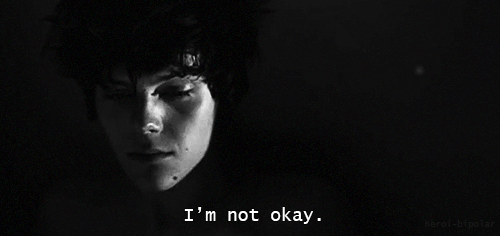
I'm going to end up rewriting The Phantom of the Opera myself with a happy ending... (Because no rewrites seem to do it ?) Between my own story ideas, rewrites of classic tales / novels, and fanfictions... My list of things to write is only growing lie down...

After a rewrite that I recommend is Phantom by Susan Kay which is good, and even if Christine ends up with Raoul and Erik die, it is clear that she loved Erik more and even had a child with (only) him, in addition to have recover his cat back, which Raoul fully accepted. (Even if he was not at all a fan of the cat with whom the hatred seemed mutual) But in any case, Phantom by Susan Kay is another variation on Erikstine's tragic love story.

#sing me forgotten#phantom#susan kay phantom#the phantom of the opera 25th anniversary#phantom of the opera 25th anniversary#phantom of the opera andrew lloyd webber#the phantom of the opera#phantom of the opera#le fantome de l'opera#gaston leroux#andrew lloyd webber#the phantom of the opera andrew lloyd webber#jessica s. olson#erikstine#erik x christine#christine x erik#erik and christine#christine and erik#erik/christine#poto e/c#e/c#isda x emeric#emeric x isda#isda and emeric#emeric and isda#susan kay
9 notes
·
View notes
Text
A walk in a formal Chinese garden is likely to take you around large standing stones of fantastic shapes with names like the Barrier of Clouds (at the entrance to the reading room of the Master of Nets in Suzhou) & the Divine Conveyance Dragon Rock, the Elder Brother Rock, awesome displays, works of nature––transposed to an utterly sedate, ornamental setting of pond lotus & mandarin ducks. The most prized ones since the Tang dynasty have been limestone rocks from Lake Tai. Acted on by water over time, furrowed & riddled with cavities, the endless labyrinth within; the massive stones have always held a special fascination for poets & painters. Bai Juyi, when governor of Suzhou, hauled a great many from the lake for his garden. Their grotesque rococo beauty must have spooked him. Bai's landscape art is seen as the continuation of poetry in another medium. In Japan, the last, best custodian of Tang culture outside China, the concept was taken up & developed into the austere scattered-rock garden, a grid of raked gravel with a few rocks, the barest moss. A stone of any size is a unit of time. What does a Tang poem read like? A Tang quatrain, 4 x 5 or 4 x 7, reads like a Japanese scattered-rock garden. Nature comes to rest warily in a grid. While the fantastic standing stones in Chinese gardens are forms of sculpted time, the grid of raked gravel with a few rocks literally reads like a Tang poem. In either mode, the bafflingly intricate wormholes of the craggy stone enclosure––an inward journey––& the grid of the austere rock garden––a pristine outward display––one touches time & time touches you like you weren't there. The standing stones do not explain, nor do the grids describe.
from wong may's afterword to in the same light: 200 poems for our century from the migrants & exiles of the tang dynasty, 2021
7 notes
·
View notes
Text
It just sucks when you feel like [paper bag being crumpled into the receiver] and then whenever you DO [car going by at speed] all you get in return is [ferry fog horn carrying up from the estuary the sound of a small church transposed into the mode of a world constantly in motion and unable to slow down]. Like I really dont ask for much but I don't know what to do about it. I might go to the woods
6 notes
·
View notes